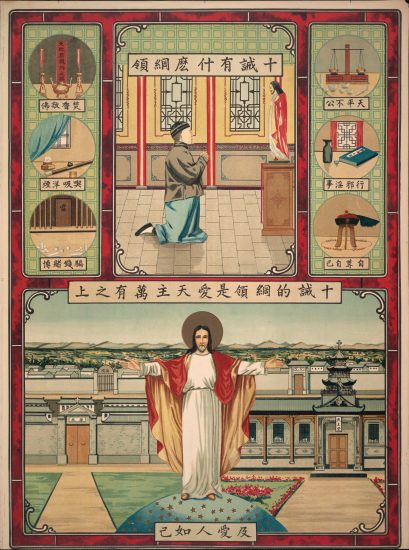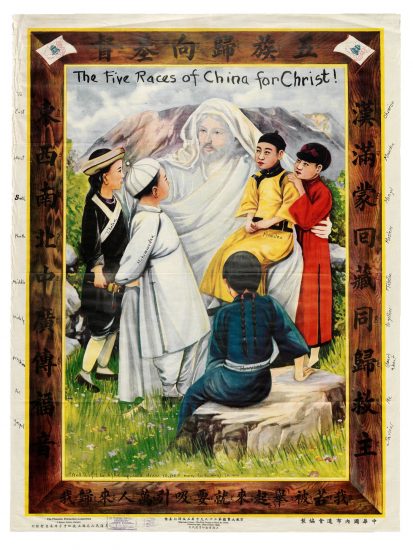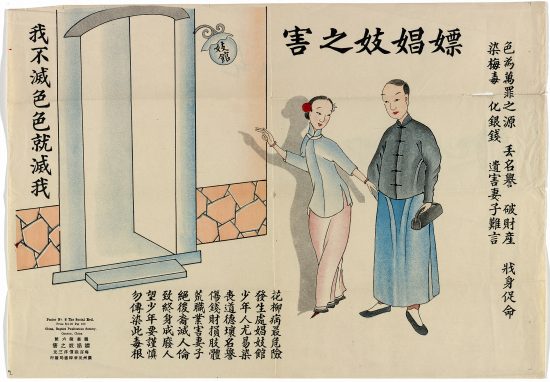 ¹What is the Greatest Salvation
¹What is the Greatest Salvation
This poster titled What is the Greatest Commandment is a vibrant poster that contains a large amount of content. In addition to the drawing of Jesus present in the center of the poster, it also contains references to heaven, judgment, prayer, different sins, and other facets of Christianity. For the purpose of this collection of posters, it will serve as the centerpiece, as in addition to its inclusion of facets of Christianity, What is the Greatest Commandment also includes a drawing of a hospital and school. The presence of these two institutions show that Christianity is making an attempt to show their importance in the success in China to draw people into their religion and change the overall perception of Christianity in China.

²The Five People of China for Christ
As discussed in Visions of Salvation, this poster titled The Five People of China for Christ, shows five children representing different ethnic groups; “Red was to represent the Han, yellow the Manchu, blue the Mongolians, white the Hui, and black the Tibetans”. Like the previous poster that makes a nod to the development of healthcare programs and education that Christianity has brought to China, this poster showing Christ as a figure that brings all these groups together is important as it plays up Christianity’s role to essentially be the glue that holds these groups together. The common theme between is not just that Christ is benevolent and provides, but that China’s wealth and unity are due to the presence of Christianity in the country.

³Anglican Calendar
In Ninlai Cao’s article A Sinicized World Religion?: Chinese Christianity at the Contemporary, Cao states that “Chinese youth spend much time socializing with one another in various church settings such as youth fellowship meetings, bible study groups, youth group outings, summer and winter camps, Christmas performance, and evangelization-related activities.”⁴ Like the previous posters, Christianity elevates itself to a level on par with traditional Chinese customs; what sticks out in this 1948 Chinese calendar is the inclusion of the Christmas holiday listed with other important dates in the Chinese calendar. In addition to Christmas being listed on December 25th, the calendar also has other important dates, including the death of Sun Yat-sen and The National Day. Moreover, the calendar has text asking Jesus’s support to “Christianize” both families and the country. The presence of Christmas as a listed holiday demonstrates the importance of Christianity, saying that just as Christianity develops vital institutions and binds together the ethnic groups of China, so too are Christian holidays on the same level of importance as Chinese national holidays.
⁴ Cao, Religions, 6

⁵The Harm of Hiring Prostitutes
This last poster is titled The Harm of Hiring Prostitutes, and depicts a man and a woman in front of a brothel with a description that talks about the dangers of lust and venereal diseases. While this poster does not outright describe the good that Christianity does for the country or place Christianity at a level on par with other Chinese culture, it does provide Christian context for combating against the dangers associated with prostitution. Instead of just warning about venereal disease, the poster specifically references sin, and says that the sin of lust is the root of the danger. This places this poster in line with the first three as it shows that repentance of sin and the acceptance and presence of Christianity is what will hold the country together.
Christianity is represented throughout these posters as linked both culturally with China and linked to the success as China as a state. Christian posters demonstrated to the Chinese people that Christianity played an important role in areas of unity, success, and morality. Prostitution was still legal in China in the 1920s, and posters like The Harm of Hiring Prostitutes even demonstrated that Christianity didn’t exist in China just to get more members, but to do the right thing; according to Ireland, legal prostitution “was perhaps the single greatest source of employment for women,” and by arguing against prostitution the Christians could have been risking a large group of potential converts.⁶
⁶Ireland, Visions of Salvation, 39
In the introduction to Visions of Salvation, Daryl Ireland references one of the key differences between Christianity in China vs. Christianity in the western world, explaining that “Christianity may be a religion of the Book, but in China it would have been popularly recognized by its ubiquitous images. Posters hung in the tea rooms and on city walls and temple gates; they were pasted on placards for street evangelism and tacked on the street-facing doors of Christian homes. Posters were the public face of Christianity.”⁶ China placed a lot of emphasis on posters throughout the 20th century, and the CCP would continue to use posters to sway the public opinion of Chinese citizens far into the latter half of the 20th century. In Asian economic and political issues, Frank Columbus describes the use of these posters, explaining that the posters would be used to promote patriotism, health, and other values the CCP wanted to elevate.⁷ Likewise, Christian missionaries placing imagery of Christianity as something that is both culturally Chinese and that causes greater success for the nation would likely have had a great affect of swaying opinion towards Christianity.
⁶ Ireland, Visions of Salvation, 7
⁷Columbus, Asian and Economic political issues,
Bibliography
1. “What Is the Greatest Commandment?” What is the Greatest Commandment?, n.d. Christian Chinese Posters.
2.”The Five People of China for Christ,” The Five People of China for Christ, n.d. Christian Chinese Posters.
3. “Anglican Calendar,” Anglican Calendar, 1948, Christian Chinese Posters
4. Cao, Nanlai. 2019. “A Sinicized World Religion?: Chinese Christianity at the Contemporary Moment of Globalization” Religions 10, no. 8: 459. https://doi.org/10.3390/rel10080459
5.”The Harm of Hiring Prostitutes,” The Harm of Hiring Prostitutes, n.d. Christian Chinese Posters
6. Ireland, Daryl R., and Peter Gue Zarrow. Visions of salvation: Chinese Christian posters in an age of revolution. Waco, TX: Baylor University Press, 2023.
7.Columbus, Frank. Asian economic and political issues. New York: Nova Science Publishers, Inc., 2004.
